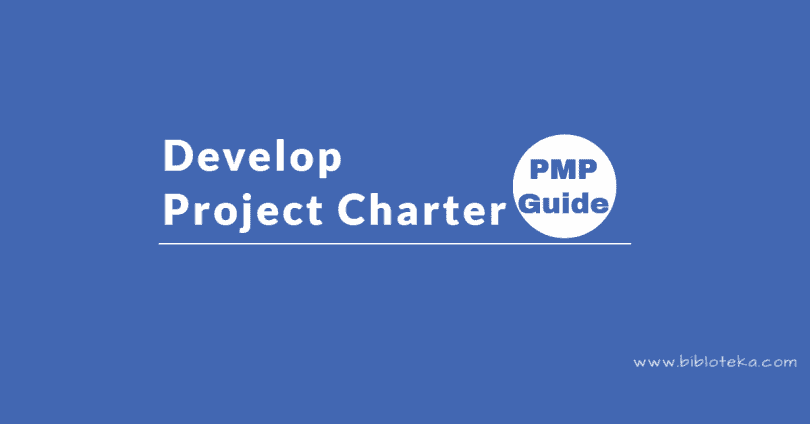Developing a project charter is the process of developing a document that formally authorizes the existence of a project and gives the project manager the authority to apply the organizational resources to the activities of the project.
The key benefits of this process are the establishment of a direct link between the project and the organization’s strategic objectives, the creation of a formal project record and the demonstration of the organizational commitment to the project.
The inputs you need to develop the project charter
- Business documents
- Agreements
- Enterprise environmental factors
- Organizational process assets
1-Business Documents
A business case is used to justify the (Return on Investment) ROI, Cost-Benefit Analysis (CBA) of undertaking the project. It talks about the opportunity, and its pros, cons, any mathematical calculations to justify the project, and projects of the overall benefit – in qualitative and/or quantitative figures. If there is a real business case to do the project, then only it should be undertaken. However, people always have pet projects, and the ROI calculations may not have been really done. If a business case is provided, the project manager can get an idea about the Cost, Opportunity, PV, NPV, IRR, Sunk Cost, Payback period, etc., and understand the financials behind the project.
- Business Case is most widely used to create the project charter.
- In the business case, the business need and the cost-benefit analysis are presented to justify and set project boundaries.
- The business case is created as a result of (Market demand, Organizational need, Customer request, Technological advance, legal requirement, Ecological impacts, and Social need)
- The project manager does not update or modify the business documents since they are not project documents; however, the project manager may make recommendations.
2-Agreements
This idea may have come about from a customer’s approval of an Agreement, Contract, PO, proposal. This agreement or contract between your client and you will have the schedule, budget, high-level specifications, suggested strategy, and clear terms and conditions, financials, milestones, etc. listed, and because it is a contract, you will be bound by the terms and conditions and you will be expected to adhere to them. And it’s best to be in writing for external clients.
- This can take the form of contracts, memoranda of understanding (MOUs), service level agreements (SLA), letters of understanding, letters of intent, verbal agreements, email or other written agreements.
- Usually, a contract is used while an external client is carrying out a project.
3-Enterprise Environmental Factors
It’s not our direct control of the environment. Weather, state, situations, office politics, government policies, country politics are all beyond us. We have to live with them … whether we like them or not. Similarly, there are environmental factors within the company (enterprise) with which we have to live, such as the organizational structure, the risk profile of the company, the risk tolerance of stakeholders, their approach to quality, percentage of stakeholders.
It is necessary to consider the political climate, the culture of the organization and then prepare the project to safeguard the internal environmental factors.
4-Organizational Process Assets
Each organization has its own internal policies, procedures, checklists, templates, as well as archives of past project documents. We need to understand these internal policies, procedures (transfer policy, travel policy, salary advance procedure), procurement procedures, preferred list of vendors, policy on 3 quotations, select the cheapest or best value quotation, and then improve them.
For some cases, the project manager may not have adequate expertise, or may require more knowledge on some aspect of the project. In these situations, it is better to contact the PMO for more details. It may be the first project of the project manager, but it is most certainly not the organization’s first project.
Tools & Techniques to Develop a Project Charter
1- Expert Judgment
This is not the judgment of the project manager … rather, it is the subject matter experts (SME) who can provide the best ways to gather information and create a solid, robust, flexible and workable project charter that can be achieved.
If you do not have in-house experience you can hire an external consultant to do the task. Experts are usually available but, with the aid of your sponsor or PMO, you might need to locate them inside the company.
2-Data Gathering
Brainstorming:
The technique is used to identify a list of ideas in a short period of time. It is conducted in a group environment and is led by a facilitator. Brainstorming comprises two parts: idea generation and analysis. Brainstorming can be used to gather data and solutions or ideas from stakeholders, subject matter experts (SME), and team members when developing the project charter.
Focus Groups:
Bring together stakeholders and subject matter experts to learn about the perceived project risk, success criteria, and other topics in a more conversational way than a one-on-one interview. A trained moderator guides through an interactive discussion.
Interviews:
Used to obtain information on high-level requirements, assumptions or constraints, approval criteria, and other information from stakeholders by talking directly to them.
3-Interpersonal and Team Skills
Conflict management can be used to help bring stakeholders into alignment on the objectives, success criteria, high-level requirements, project description, summary milestones, and other elements of the charter.
Facilitation is the ability to effectively guide a group event to a successful decision, solution, or conclusion. A facilitator ensures that there is effective participation, that participants achieve a mutual understanding, that all contributions are considered, that conclusions or results have full buy-in according to the decision process established for the project and that the actions and agreements achieved are appropriately dealt with afterward.
Meeting Management includes preparing the agenda, ensuring that a representative for each key stakeholder group is invited, and preparing and sending the follow-up minutes and actions.
4-Meetings:
Meetings are held with key stakeholders to identify the project objectives, success criteria, key deliverables, high-level requirements, summary milestones, and other summary information.
Develop Project Charter Outputs
1-Project Charter
It records high-level project/product details or results in projects that are intended to meet these needs
- Project purpose
- Name of sponsor or persons authorizing project charter
- Objectives and success criteria
- High-level requirements
- Overall project risk
- Assigned project manager, responsibility and authority
- Milestone schedule
- Key stakeholders list
- Preapproved financial resources
- Project Approval requirements
- Project closing criteria
2-Assumption Log
Once the project is initiated, high-level strategic and operational assumptions and constraints are usually identified in the business case and will flow into the project charter. During the project, lower-level activity and task assumptions are developed such as identifying technical requirements, forecasts, schedules, risks, etc. During the project life cycle, the assumption log records all assumptions and constraints.
Recommended Resources
Advanced PMP Questions & Answers
See Also
PMP Questions & Answers









